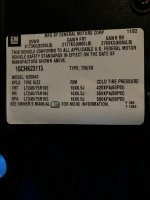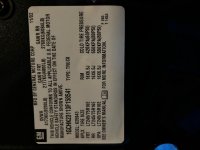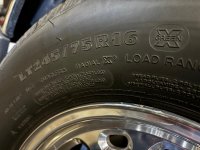My 2014 RT got a new set of tires before 2K miles. I installed Continental Pro Contact on the rear and General Altimax T43 on the rear. I used 19 PSI front and 25 PSI rear. The Altimax rear tire needed to be replaced much much earlier than the Pro Contact. I drove/rode 43K miles on the Pro Contact tire. Then I put on Vredestein Quatrac 5 front tire at 18 PSI and Vredestein Sprint rear at 20 PSI. A dealership set the tire pressure right. Some dealerships are knowledgeable. My concern is that the tires look low. I am concerned that the 18 front pressure is too low. Since the tires for automobiles require a minimum of 35 lbs which is too high for the Spyder, is that 18 PSI damaging the wires that keep the tire in place. That is, there are wires installed in the edge of the tire that give it the strengnth to remain on the tire. The argument I have with a Professional truck driving friend is that the pressure is too low. If you take a wire and bend it many times it will break. The argument is that as we drive, we are bending the wires too much and they will break. I don't think so but I'd like to hear from someone who know if there is any possibility that the steel wires will break sooner. But my tires do look too low at 18 PSI
NO, running 18 psi in those tires under that load is not damaging anything!! It's the air inside the bag (or tire) that carries the load imposed upon it - if you take a tire that is capable of carrying a much greater load at a given pressure, and you reduce that load by about one half, you
ALSO NEED to reduce that air pressure by about one half,
or your tires are OVER-inflated, with all the negatives and increased risks that go along with that!! :lecturef_smilie:
And you need to remember that non-motorcycle radial tires for cars (and Spyders!

) are
MEANT to bulge out in the sidewalls where they sit on the ground - so when you are stopped and 'looking at them', they are effectively
MEANT to look as tho they are running somewhat low in pressure!! It's the radial construction and the bagging in their sidewalls that allows them to work as well as they can do in use by keeping a larger percentage of the tread flat and in contact with the road surface during said use, especially while cornering; over-inflate them on your Spyder by as little as 2 psi and you'll be lifting at least part of that 'intended contact patch' off the road surface and reducing your traction/increasing the risk of sliding! The Radial tires we are talking about are even
MEANT to look
AND feel softer in use than your Professional truck driving friend's tires do too!!

Just remember,
YOU CANNOT TELL IF A RADIAL TIRE IS AT THE CORRECT PRESSURE JUST BY LOOKING! They will even look 'flat' if they are somewhat dangerously over-inflated; and in fact, if they
DON'T have that 'bulge in the sidewall' that makes them 'look a bit low' in pressure, then they
CANNOT do their best for you or work in the way they were designed to work, and you
WILL be running significantly increased risks of loss of traction, control, &/or catastrophic tire failure!! :gaah:
I've said it here before, and I guess I'll probably say it again too, but just like back in the day it took many car drivers quite a while to get used to the look and feel of radial tires vs that of cross ply tires way back when radials first came out, with their bulging sidewalls, softer ride, and 'sorta spongier' feel - all if which lead some to over-inflate their radial tires, thereby causing accidents &/or blow-outs as a result! :yikes: Well just like that, if you've been running around on over-inflated radial tires fitted to your Spyder for a while, then changing to running a much more appropriate (lower) pressure
WILL look and feel different for a while! But you should get used to it pretty quickly,
IF you persist and start feeling & recognising the advantages you can get thru not running over-inflated radial tires on a vehicle that weighs less than half of the tire's maximum load rating! :lecturef_smilie:
I reckon that you don't even think twice about running the tires on your car at less than their maximum pressure &/or load rating, so why all the fuss about running effectively the same tires at an even lower pressure when the load imposed upon them is even less again?! :dontknow:
Btw, if you're still running 20 psi in your rear Vredestein and you'n any load you put on your Spyder doesn't top saaay, 450+ pounds or so, then you should probably also drop your Vredestein rear tire pressure to no less than 14 psi and no more than 18 psi, or you'll wear that one out quicker than you need to as well,
AND you'll also be running at a reduced traction level; an increased risk of damage from road debris etc; subjecting it and yourself to a harsher ride than is necessary; you'll be over-working & effectively prematurely cooking your suspension; and probably more besides that I've missed atm too!!
Very few people are big enough or overload their Spyder enough to need to run more than 18 psi in any of the 'real' car tires/sizes that'll safely fit our Spyders! :banghead:
Just Sayin' :thumbup:



